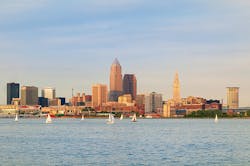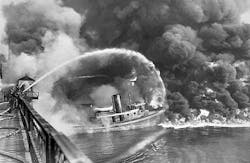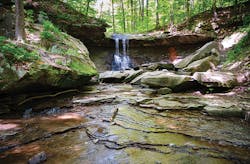It was 1969; the moon landing launched the US into first place in the space race, a little town called Woodstock had a big event with 350,000 people, PBS hit the airwaves, and Seiko introduced a quartz watch. The Concorde flew its test run in France, and the new microprocessor would change life as we knew it.
And that summer in Cleveland, OH, both daily newspapers reported another event, but with very little fanfare.
At 12:30 p.m. on June 22, 1969, the Cuyahoga River caught fire—again. This was the river’s 13th fire, and not too different from the previous ones, despite reports of flames five stories high. It was caused by sparks from a passing train that ignited the thick sludge coating the bridge trestles.
In that era, heavy pollution was acknowledged as the price to be paid for the revenue generated by industries historically sited along the Cuyahoga, which used the river as their primary source for disposal. But a photo of the river on fire in Time magazine a month later quickly brought world attention to a serious problem that was to have two very different outcomes.
Although the fire and the pollution that caused it brought relentless criticism to Cleveland, Lake Erie, and the Cuyahoga River, it was ultimately the entire nation that benefitted. The founding of the Environmental Protection Agency, the Clean Water and Air Acts, and the first Earth Day—in fact the emergence of the “environmental movement” itself—all owe a debt of gratitude to the fire, which helped make the public aware of the deplorable conditions of America’s air and waterways.
Now, in 2019, half a century later, the Cuyahoga River is once again in the news. But this time the City of Cleveland and multiple northeast Ohio organizations are celebrating “River Rebound,” demonstrating to the region and the world how the results of five decades of commitment, investment, and cooperation of public and private interests, supported by regulatory policy, have accomplished what most believed was an impossible task.
Now considered a benchmark in environmental restoration, the river’s comeback is a long story that involves so much more than cleaning up pollution. But the effort’s success and its multiple milestones must really start with a look to its history, beginning more than two centuries ago.
The Final Frontier
According to legend, a confederacy of six Indian nations called the Haudenosaunee, comprising Seneca, Cayuga, Oneida, Onondaga, Mohawk, and Tuscarora tribes, originally named this river the Cuyahoga, or crooked river, which a glance at any northern Ohio map will confirm.
“Historically, rivers have always acted as borders—between states, countries, jurisdictions—and the Cuyahoga is no exception,” says Tom Donovan, CEO of Canalway Partners.
A dividing line between regions, the Cuyahoga River “was the demarcation of Ohio territory, and the place where the three pivot points of history occurred that gave rise to its prominence and were integral to Cleveland’s—and Ohio’s—development.
“On the eastern side it was the Connecticut Land Company’s holding, called the ‘Western Reserve,’ which at that time, the late 1700s, was literally the western boundary of America as it existed,” he says.
“On the west side of the River was Indian territory and unsettled land. When a speculator named Moses Cleveland was sent out from the Land Company to lay out township plots, the City of Cleveland was developed on the eastern side of the river, and another entity, Ohio City, emerged on the western side.” Even to this day, he notes, metropolitan area residents still define themselves as being eastsiders or westsiders.
However, back in the 18th century, there was no way to cross the crooked river, which was flanked by steep cliffs and a flat river valley.
“So, a floating bridge with ropes attached to each side conveyed people across the water,” explains Donovan. “But then the Mayor of Cleveland gets together with a developer and builds the first drawbridge, which creates even easier passage.”
However, there is a little-known historical footnote. The drawbridge successfully brought in business from Ohio City merchants. In an ensuing skirmish over territory ownership, the Ohio City side “tried to blow up the drawbridge, in what became known as the Bridge Wars of 1836.”
After this event, “The City of Cleveland absorbs Ohio City, expanding its reach, and America starts to move west, and that was the first pivot of history,” reports Donovan.
The second turning point that brought growth to the region was devised by George Washington, he says. As a surveyor, Washington saw that the country could not easily expand westward, as it was literally hemmed in geographically by the barrier of the Appalachians.
“So, Washington has an idea to create a transcontinental waterway from the Atlantic seaboard in New York via the Hudson River to Lake Erie. This became the Erie Canal. It was opened in 1825, with the later Ohio and Erie Canal, linking Cleveland southeast to the Ohio River, opening in 1832. The waters for that canal were supplied by various rivers and lakes including Summit Lake—the Cuyahoga that had been dammed to channel and fill the new transport canal.”
Now, with transportation readily available, activity in the area heated up. Anchored by the canal’s basin, a maritime district expanded at the Cuyahoga’s mouth at Lake Erie; it later adopted the name “The Flats,” which continues today and accurately describes this shallow area at the base of the river valley where the Port of Cleveland was established.
The stage was set for industrial success. The River was open for business—and it came.
“As goods were brought in, this frontier wilderness grew to become the third most populous—and richest—a movement that was all started by the canal and facilitated by the river,” says Donovan.
The third pivot point he describes involves the people who came to the region and the development they brought with them. “This valley, with the Cuyahoga River acting much as a railway would, set Cleveland up as an industrial center. It’s our workshop, and major players launched the region toward incredible prosperity.”
John D. Rockefeller, who pioneered oil refinery, made Cleveland the country’s center of petroleum production and distribution. Sherwin-Williams opened its paint manufacturing facility in 1870, while the Port of Cleveland and the Cuyahoga River-based steel mills became the destination of ore arriving from Minnesota and Canada on massive ore boats. As vessels increased in size, they could not navigate the hairpin turns, so a new shipping channel was dredged and lined with steel to accommodate the 600- to 700-foot ships.
Foundries, ironworks, and asphalt and chemical plants all set up shop in the region, making Cleveland an industrial hub. The center of activity was where water and rail met at the Cuyahoga River.
Why is this backstory important to the 50-year celebration in 2019? Donovan reflects that the wealth generated in this era from 1870 to 1920, now known as the Gilded Age, built not only a city but a civilization.
“It gave thousands of new immigrants a chance to work, and the personal wealth generated by the industrialist entrepreneurs was generously shared in public efforts. They built museums like the celebrated Cleveland Museum of Art. The Cleveland Orchestra, the award-winning Cleveland Metroparks system, and the founding of the United Way are just a few examples of this legacy.”
But, he adds, “We should not lose sight of the double-edged sword that brought us to where we are now.” The success and the wealth were possible because these industries were disposing of all their waste in the river, at no cost whatsoever to themselves.
“Without any regulations, theriver was literally a huge sewer.From 1868 to 1969, it routinely caught fire, and in fact, most of those were much more severe [than the 1969 fire]. What most people don’t know is that the photos featured in the August 1969 issue of Time magazine were actually from a 1952 fire that was very damaging,” he says. There are no photos known to exist of the 1969 fire.
“At one point in the late ’60s,I was a hatch tender, unloadingiron ore and pellets that would feed the steel mills,” recalls Donovan.“The river was black and ugly and boiled like a cauldron, and the rule was that if you fell in the water you went right to the hospital; it was that toxic, that terrible.”
Why Things Changed
Jane Goodman, founder and CEO of Cuyahoga River Restoration, a not-for-profit organization founded in 1988 as the facilitating organization for the Cuyahoga River Area of Concern (AOC), also recalls the river’s status.
“Virtually nothing lived in the Cuyahoga except pollution-tolerant fish, certainly nothing you could eat. It was full of debris, and it in no way resembled a waterway. But we have to remember that at the time, the collective conscience was not focused on the environment; it wasn’t part of our vocabulary the way it is today. We were focused on antiwar protests, civil rights, and a different set of social issues. After the Clean Water Act and the national attention directed toward the river, things changed.”
Donovan says that the time was right for that change. “The first African-American mayor, Carl Stokes, had just been elected in Cleveland, and he invited his brother Lou, who was on a House committee giving testimony on infrastructure, to come to Cleveland and see the problem firsthand.”
This was the beginning, says Donovan. “The meeting was well covered by the media, including Time magazine. The story did a number of things, including generating a joke-fest by Johnny Carson about Cleveland and inciting a perversely negative reputation for Cleveland as a place of disgrace for decades to come.”
But after the policymakers saw in person what was happening, the story really became the tipping point for initiating action. This led to appropriations to clean up the environment, and eventually helped spur the passing of the Clean Water Act and the formation of the Environmental Protection Agency. In 1970, Earth Day was established as an annual event on April 22.
“Collectively, this was the fodder that was the springboard to convert how we were doing things and how we could do them better,” says Goodman.
And there were other spin-offs. Goodman says that Earth Day was the catalyst to begin teaching environmental science in schools. “Up until then they were teaching natural history as what the earth is—rocks, oceans, land, soil, and so forth. But they weren’t teaching how it works. This was a new approach and was the seeding ground for broadening environmental science as a science.”
A Stadium Full of CSOs
Although enacting regulations that prevented industry from dumping waste into the river was vital, the reshaping of policy concerning stormwater was also needed, explains Jeannie Smith, community media relations manager for the Northeast Ohio Regional Sewer District (NEORSD).
“Back then, we had significant industrial pollution, oil slicks, and an aging sewer system that needed updating, and a lot of the CSOs [combined sewer overflows] were sending water into the environment and the river. Our organization was created in 1972, and since then we’ve invested over $5 billion in sewer infrastructure across 62 communities of the Cleveland metropolitan area.
“As of right now we have reduced the CSOs from 9 billion gallons in 1972 to half that, about 4.5 billion gallons, and we’re continuing to reduce those numbers.”
So, how much is 9 billion gallonsof water?
“I get asked that a lot, and we estmate it’s enough to fill the Cleveland Browns’ stadium 113 times, so a pretty substantial amount,” she says.
Through a number of construction projects and the building of seven tunnels “big enough to drive a Mack truck through,” water has been diverted to new treatment plants and has alleviated the overflow going to the Cuyahoga River, says Smith. She adds that the projects have been wholly funded through the revenue stream from ratepayers, “who understand that clean water and reducing pollution is essential.”
She says, “If you look at the reputation of your community, and if there are pollution issues that affect your drinking water, it can be a drastic situation with terrible consequences. People don’t want to move there, businesses don’t want to open their doors. There is a disincentive to growth and success. Protecting the source of drinking water means protecting all your water resources to ensure it is safe. The Great Lakes are the largest surface freshwater source in the world, and our Project Clean Lake is a long-term project to reduce pollution and mitigate its effects.”
A Complex Personality
Noting that the streams and tributaries of the Cuyahoga all lead to Lake Erie, Goodman explains how the river is much more than what is commonly perceived as a shipping channel.
“First, you have to understand that the river itself has four distinct personalities, in that the watershed that feeds it covers rural, exurban, urban, and industrial areas.” Goodman explains that this includes more than 800 square miles of subwatersheds in parts of four counties.
“The river itself is a hundred miles long, and the first 25 miles is the section designated as the Upper Cuyahoga State Scenic River, where it runs through forested parkland and protected areas and then into Lake Rockwell, a reservoir.
“After leaving the reservoir, it gets more urbanized through the city of Kent and then passes through more suburban communities as it drops down into Akron and Cuyahoga Falls and then into the Gorge area, now a well-known Mecca for whitewater kayaking.”
From Akron, “it turns north and becomes the lower Cuyahoga, flowing through the Summit County park system, the Cuyahoga Valley National Park, and the Cleveland Metroparks.
“Now, nearing its end, we come to the navigation channel. For this last six miles, starting approximately at the steel plant where the last fire burned, it is basically a 23-foot-deep, steel-walled industrial shipping channel,” says Goodman.
These last 6 miles of the Cuyahoga River are designated as a federal navigation channel. However, the upper portions of the river contribute considerable sediment into this channel, which must be maintained at a 23-foot depth to allow the 700-foot freighters their passage to the steel mills.
Each year, the US Army Corps of Engineers, which has oversight of this “maritime highway,” dredges about 225,000 cubic yards of sediment from the channel. Historically, this dredge has been deposited in a confined disposal facility. However, finding a reuse for the clean sediments is an active pursuit—as compost material and for fertilizer, for example. In 2009, a brownfield site on the river was remediated with 300,000 cubic yards of sediment, creating the Cuyahoga Valley Industrial Center.
Goodman says it is the last half—about 46.5 miles—of the river that is the AOC, where the focus has been on restoration.
“Restoring stream health in those subwatersheds is critical. Streams are like the branches of a tree. Everything that’s in the river starts in a creek or brook or on the land beside the main river itself. When the remedial action plan started in 1988, one of the strategies for restoring the function of the river was to develop stewardship organizations and promote oversight in these subwatersheds. If those streams work, then the system as a whole works,” she says.
Get Those Dam Structures Out
Shifting gears in activity and process was another turning point. Watershed specialist Elaine Marsh at Summit County Metroparks recalls that by the mid 1980s, stakeholders realized if long-term, meaningful effect was to be achieved, a new approach was needed—one that went beyond simply limiting and controlling discharges.
Marsh is a lifelong environmental professional as well as a co-founder of Friends of the Crooked River, formed in 1990 “to give the 100-mile length of the Cuyahoga River a voice in advocacy, education, and organizing diverse volunteer projects,” she explains.
She cities the 1988 remedial action plan, initiated through the US-Canada Great Lakes Water Quality Agreement, for Ohio’s four Great Lakes AOCs. The plan’s goal was to restore all impaired beneficial uses through an ecosystem approach.
“Basically, this means removing impediments and addressing problems that prevent the river from being used as it could and should be. This is much more than just regulation to stop harmful industrial discharge and illegal dumping.
“For example, since the 1800s, the installation of dams along the river—for industry, for power, to control flooding—had successively altered the flow. The river can’t perform as nature intended, and that introduces many consequences.”
Those consequences include interfering with sediment transport, reducing benthic populations, obstructing many natural biological and chemical processes, reducing dissolved oxygen, and trapping toxins. Fish, shore plants, and wildlife habitats are all affected. Furthermore, “many of the dams are now obsolete as industry and technology have changed," she says.
“We have spent years wrangling with permits, engineering studies, historic and scientific reviews, and public buy-in to get four dams removed by 2007, at a cost of more than $8 million. And more are slated to come down.”
But success follows persistence. In the City of Cuyahoga Falls, two dams, the Sheraton and the Powerhouse, both built in 1914 to produce energy for now-abandoned industries, were designated as “having no existing or historic value.” Removing them would reinvigorate the entire area and would address the issues of low dissolved oxygen, total maximum daily load (TMDL), and non-attainment of aquatic life uses.
“The City was very enthusiastic in not only the dam structure removals, but also in having crews work on debris cleanup to capture all rebar from the river for safety reasons,” she notes.
City engineer Tony Demasi explains that construction of a deflector wall was necessary to direct low flows away from the original Powerhouse structure. The wall was built with cast-in-place concrete. Subsequent cleanup efforts by volunteers unearthed about 220 tons of small tires believed to be from the Falls Bicycle Shop, which operated nearby more than 60 years earlier. And there was one other surprise—a rusted handgun in a metal box whose serial number was traced to an armed robbery.
The dams were gone by August 2007, and revegetation began taking hold almost immediately that fall; the area transformed from blight to recreational resource. The river rapids lured kayakers and canoeists who began using the river and claimed that the challenging, even dangerous, rapids are whitewater akin only to those in West Virginia.
Marsh says the success of these and other projects on the drawing table deliver positive results and support the idea of “looking at the river as an ecosystem needing remediation and protection for future generations, versus simply stopping discharge, reclaiming wastewaters, and preventing damage.”
In the 2007 Case Studies of Dam Removal and TMDLs: Process and Results, authors Steve Tuckerman and Bill Zawiski from the Ohio EPA Division of Surface Water report the benefits of dam removal or modification. Sampling one year after removal revealed both improved dissolved oxygen concentrations and improvements in the fish community.
Commenting on the Cuyahoga Falls project, Zawiski says, “There’s movement in the water, which there always was, but the pools were kind of stagnant. It’s a real river now instead of a river with impediments.”
Marsh adds, “By looking at the river differently, through a lens of offering a multi-resource opportunity, we could demonstrate all these benefits and engage the public in these forward-thinking efforts. This is a big advance in thought, going from prevention to protection.”
It took decades to convince municipalities that this effort “was more about water quality as a quality of life, not just an environmental problem with an endless litany of financial, physical, and policy challenges,” says Marsh.
Pavement Not Required
Goodman underscores the improvements. “Adding trees, green infrastructure, land conservation, and new and improved aquatic habitat across the watershed have been key strategies to bring the Cuyahoga back to life.
“For example, the DepaveNEO component of our organization looks at stormwater as another factor to affect this whole picture. As businesses have shrunk, parking lots and paved spaces are going unused and are essentially redundant to today’s retail and industrial operations. We can get rid of those deteriorating surfaces and turn them into bioswales, increase our tree canopy, and create functioning nature in an urban environment. This does more than slow and filter water; it puts oxygen in the air, provides shade, and reduces heat island effect.”
And Donovan says the new revitalized green environment along The Flats is a far cry from the dirty and derelict industrial eyesore it once was.
“Our Canalway organization partners with several entities to achieve goals that use the existing route of the historic Ohio Canal from Cleveland to expose a new view of the river. We were the chief fundraiser for Towpath Trail Greenway, and we are heavily involved in public education and awareness over the entire Ohio and Erie Canalway Heritage Area. In the last 29 years, for example, our RiverSweep cleanup has seen nearly 20,000 volunteers participate in the pickup and recycling of 655 tons of trash along the Cuyahoga River corridor.”
Donovan adds that the river and the river valley offer the region anew identity.
“For a long time, everybody was stuck on the river fire, which is pretty negative. But we have a new identity, and instead of running away from our history we should embrace it and use its valuable message to understand where we were and how far we’ve come. Personally, I believe that the identity of Cleveland is intimately tied to the river. When you see what we have now—a success in overcoming incredible odds—I really see us as the Selma of the environmental movement.”









